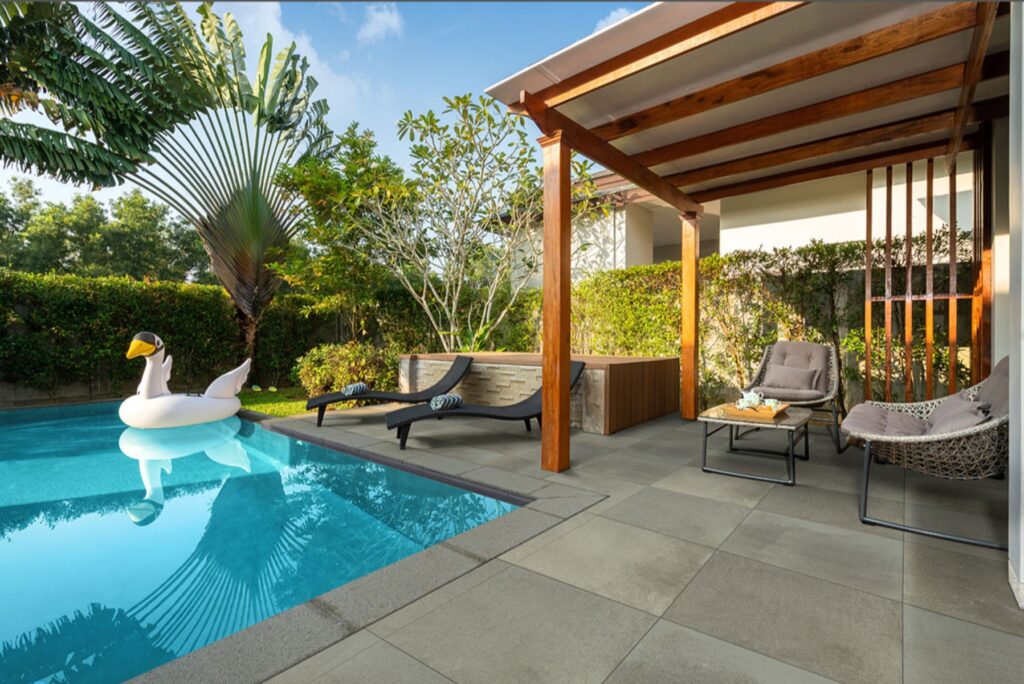“I want something maintenance free.” We hear this often in the showroom. Customers want material that is user-friendly and easy to care for. While we can certainly steer you toward less sensitive materials, it should be said that there is no perfect maintenance-free magic paving material. But there is a highly durable and quite stunning material readily on the market. Let’s talk about porcelain.
Maintenance
First things first. What does maintenance look like with porcelain? Answer: Easy Peezy lemon squeezy—even if you spill lemonade on it which is a big no-no for sensitive materials like limestone. Porcelain has made great leaps in the past ten years in terms of design. Nearly all outdoor porcelain is engineered to be stain and acid resistant. That means your guests can spill wine on the patio at night and you can clean it the next day—stress free. Ok, so it’s easy to clean and doesn’t need to be sealed. That’s nice and all but how does it look?

Aesthetic
Because the surface of porcelain is an image glazed onto a clay body, the possibilities for styles are limitless. From the warm creamy tones of limestone and travertine to the cooler notes of bluestone and slate, porcelain can mimic colors of any natural stone. And even more, like wood grains. Porcelain comes with hues and color washes sure to satisfy any style. Most porcelain tiles are 100% UV resistant so the color lasts and doesn’t look uneven depending on sun/shade conditions. What designers love about porcelain is that some lines allow for a seamless flow from indoors to outdoors.

Safety
All outdoor porcelain is now certified slip-resistant. Gone are the days of minding your steps when walking on wet porcelain. So, you should feel confident and safe even when installing around a pool.

Installation
Many customers are looking to stay away from pouring slab base for their pavers. You now have the option of laying porcelain tiles over base rock and sand but how would a ¾” thick piece of porcelain hold up? Perfectly, that’s how. Outdoor porcelain is engineered to be installed over base rock and sand, leaving you with a lighter project cost overall. And since these aren’t mortared down, should you have a problem such as the occasional chipping or breaking, you can remove the bad piece and lay a new one down. Just remember to buy a few extra pieces during the original project so you’re prepared down the road. Another popular installation method these days is the pedestal system. Here you can have all your drainage hidden under the porcelain instead of grates needing to be cut into the surface. The joints stay the same thin size but no sand is filled into the gaps. Now you have a clean, modern look as well as an effective water drainage solution.
Cost
And finally we get to the big one: how much? Although it’s difficult to give absolutes because porcelain comes in different qualities, as a loose rule porcelain tends to fall somewhere between the price of concrete pavers and natural stone—usually. If you’d like specific pricing, would like to pick up a sample or have any other questions about porcelain, please visit a PBM location nearest you.
Thank you for reading the Design & Build Blog. If you have any questions or a topic you’d be interested in learning more about – leave us a comment below or on our social media. Even better, you can reach out to us directly.





Great guide on outdoor porcelain tiles! The detailed insights on durability and installation are super helpful. Thanks for sharing!